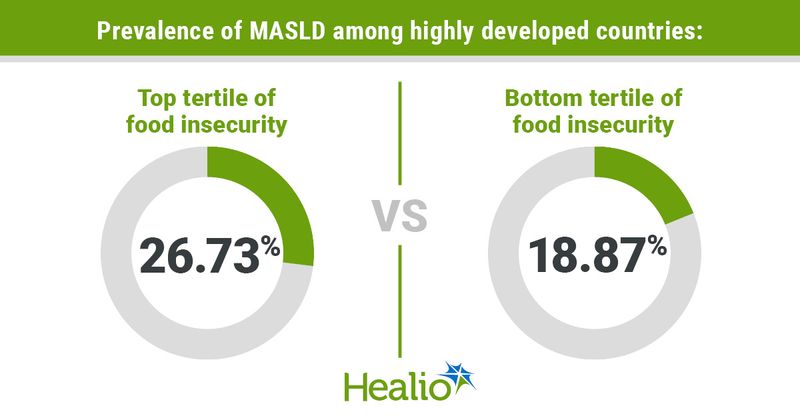Food insecurity, socioeconomic development influence global prevalence of MASLD
Click Here to Manage Email Alerts
Key takeaways:
- Researchers observed the highest MASLD prevalence in North Africa and the Middle East.
- Higher disease prevalence was associated with obesity, type 2 diabetes and low physical activity.
Country-specific public health policies that target metabolic dysfunction-associated steatotic liver disease risk factors, such as food insecurity and physical activity, may play a key role in mitigating the global burden of disease.
“Recent evidence suggests that food insecurity may significantly influence MASLD prevalence by affecting metabolic risk factors like obesity and type 2 diabetes,” Zobair M. Younossi, MD, MPH, of The Global NASH/MASH Council and Center for Outcomes Research in Liver Diseases, and colleagues wrote in Journal of Hepatology. “By highlighting the role of food insecurity, we seek to provide better insights into its impact on the burden of MASLD in different regions of the world.”

To do this, Younossi and colleagues conducted a cross-sectional ecologic study using MASLD prevalence and liver-related mortality data from 2021’s Global Burden of Disease Study, which they classified into quartiles, and country-level food security data from the Food and Agriculture Organization of the United Nations. They also utilized each country’s Socioeconomic Demographic Index (SDI), with higher values signifying a higher level of development.
Across 204 countries, the median prevalence of liver-related mortality and MASLD in 2021 was 21.77% (range, 14.14-48.18) and 2.92 per 100,000 (range, 0.42-10.79), respectively. Researchers observed the highest MASLD prevalence in North Africa and the Middle East (41.7%) and the lowest in high-income countries (17.31%).
Higher MASLD prevalence was associated with obesity (beta = 0.194; standard error [SE] = 0.034), type 2 diabetes (beta = 0.416; SE = 0.094) and low physical activity (beta = 1.003; SE = 0.173) in models adjusted for age, gender and SDI, while lower prevalence was linked to unaffordability of a healthy diet (beta = –0.089; SE = 0.032) and undernourishment (beta = – 0.149; SE = 0.058).
Further, prevalence of MASLD was significantly higher in high-SDI countries in the top tertile of food insecurity vs. those in the bottom tertile (mean, 26.73% vs. 18.87%), while less developed countries experienced the opposite (19.45% vs. 24.96%).
Results also showed that liver-related mortality was linked to older age, obesity status, type 2 diabetes and metabolic risks such as high BMI and fasting plasma glucose. There were no statistically significant differences in liver-related mortality across levels of food insecurity in SDI-stratified analysis.
“Food insecurity plays a critical role in MASLD disparities between high- and low-SDI countries,” Younossi and colleagues wrote. “In this context, developing country-specific policies to address low-quality, ultra-processed food in high-SDI counties and programs to deal with poverty and lack of adequate nutrition in low-SDI counties will be important. Furthermore, policies to improve physical activity in both high- and low-SDI countries can have potentially positive impact on metabolic health, including MASLD.”
They continued: “In this context, targeted public health strategies addressing these risk factors in countries with the highest burden of MASLD are essential for mitigating the global burden of MASLD.”
